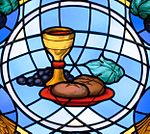| Solemnity of the Most Holy Body and Blood of Christ | |
|---|---|
 Corpus Christi procession. Oil on canvas by Carl Emil Doepler. | |
| Official name | Solemnity of the Most Holy Body and Blood of Christ |
| Also called | Corpus Domini |
| Observed by | Public holiday in 25 countries (in 3 of them, only regionally) |
| Liturgical color | White |
| Significance | Real Presence of Christ in the Eucharist |
| Date | Thursday after Trinity Sunday; 60 days after Easter, or the Sunday immediately following this |
| 2023 date | June 8 |
| 2024 date | May 30 |
| 2025 date | June 19 |
| 2026 date | June 4 |
| Frequency | Annual |
| Related to | |
| Part of a series on the |
| Eucharist |
|---|
 |
The Feast of Corpus Christi (Ecclesiastical Latin: Dies Sanctissimi Corporis et Sanguinis Domini Iesu Christi, lit. 'Day of the Most Holy Body and Blood of Jesus Christ the Lord'), also known as the Solemnity of the Most Holy Body and Blood of Christ,[2] is a liturgical solemnity celebrating the real presence of Christ in the Eucharist; the feast is observed by the Latin Church, in addition to certain Western Orthodox, Lutheran, and Anglican churches. Two months earlier, the institution of the Eucharist at the Last Supper is observed on Maundy Thursday in a sombre atmosphere leading to Good Friday. The liturgy on that day also commemorates Christ's washing of the disciples' feet, the institution of the priesthood, and the agony in the Garden of Gethsemane.
The feast of Corpus Christi was proposed by Thomas Aquinas, Doctor of the Church, to Pope Urban IV, in order to create a feast focused solely on the Holy Eucharist, emphasizing the joy of the Eucharist being the Body and Blood, Soul and Divinity of Jesus Christ. Having recognized in 1264 the authenticity of the Eucharistic Miracle of Bolsena, on input of Aquinas,[3][unreliable source?] the pontiff, then living in Orvieto, established the feast of Corpus Christi as a Solemnity and extended it to the whole Roman Catholic Church.[4][5]
The feast is liturgically celebrated on the Thursday after Trinity Sunday or, "where the Solemnity of The Most Holy Body and Blood of Christ is not a holy day of obligation, it is assigned to the Sunday after the Most Holy Trinity as its proper day".[6]
At the end of Holy Mass, there is often a procession of the Blessed Sacrament, generally displayed in a monstrance. The procession is followed by the Benediction of the Blessed Sacrament.[7] A notable Eucharistic procession is that presided over by the Pope each year in Rome, where it begins at the Archbasilica of St. John Lateran and passes to the Basilica of Saint Mary Major, where it concludes with the aforementioned Benediction. Corpus Christi wreaths, which are made of flowers, are hung on the doors and windows of the Christian faithful, in addition to being erected in gardens and fields.[7]
The celebration of the feast was suppressed in Protestant churches during the Reformation for theological reasons, because it celebrated transubstantiation. Outside of Lutheranism, which maintained the confession of the Real Presence, most Protestants denied the real presence of Christ in the Eucharist other than as a merely symbolic or spiritual presence. Today, most Protestant denominations do not recognize the feast day,[8] with exception of certain Lutheran churches and the Church of England, the latter of which abolished it in 1548 as the English Reformation progressed, but later reintroduced it.[9] Some Anglican churches now observe Corpus Christi, sometimes under the name Thanksgiving for Holy Communion.
- ^ 4 July, Antiochian Western Rite Vicariate. https://www.orthodoxwest.com/kalendar
- ^ "Solemnity of the Most Holy Body and Blood of Christ". Catholic News Agency. Archived from the original on 21 June 2019. Retrieved 21 June 2019.
- ^ "The Eucharistic Miracle of Bolsena (Orvito, Italy)". therealpresence.org. Archived from the original on 11 January 2001. Retrieved 21 June 2019.
- ^ Robert E. Alexander; John A. Elliott (1 April 2018). Livio Orazio Valentini: An Artist's Spiritual Odyssey. University of South Carolina Press. p. 43. ISBN 978-1-61117-899-9. OCLC 1019855530. Archived from the original on 21 June 2019. Retrieved 21 June 2019.
- ^ "Italy's Orvieto miracle inspires thousands during jubilee". Rome. 7 October 2013. Archived from the original on 7 October 2013. Retrieved 21 June 2019.
- ^ "Sanctissimi Corpus et Sanguis Christi." Roman Missal, 2011 Latin to English translation
- ^ a b Cite error: The named reference
Wesier1956was invoked but never defined (see the help page). - ^ "Corpus Christi, Feast of". Encyclopædia Britannica. 1974.
- ^ "Corpus Christi at Cyberbrethren". Redeemer Lutheran Church. 17 June 2006. Archived from the original on 18 July 2011. Retrieved 13 June 2022.